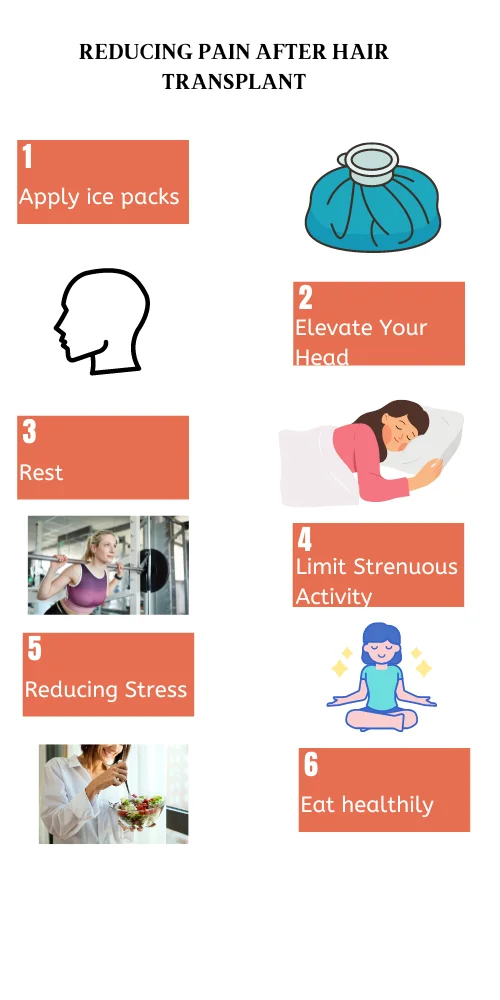Is it painful after hair transplant?
No, it is not painful after hair transplant. Hair transplant surgery has become increasingly popular as an effective solution to hair loss, however many worry that the procedure might cause discomfort during and after its performance. In this article we explore all aspects of hair transplant pain; including strategies for controlling it as well as potential side effects.
Pain during the procedure
Hair transplant surgery is performed under local anesthesia to ensure minimal to no discomfort during the actual procedure; however, you may feel some prickling sensation upon injection of anesthesia which should subside shortly afterwards.
Pain After the Procedure
As is common after surgery, discomfort and soreness in the treated areas is to be expected after recovery. This discomfort typically manifests as sunburn- or graze-like pain that typically subsides within several days; over-the-counter pain medication and applying ice packs can help ease this discomfort.
Factors Influencing Pain
Procedure Type
Follicular Unit Transplantation (FUT) typically involves making one linear incision to transfer hair follicular units, leading to more discomfort than Follicular Unit Extraction (FUE), which uses multiple small incisions to extract individual follicular units.
Pain Tolerance
Everyone reacts differently to pain; some are more sensitive than others.
Surgeon Experience
Skilled and experienced surgeons can reduce tissue damage and discomfort during surgical procedures.
Following aftercare instructions
Conforming to post-operative instructions such as using ice packs and refraining from strenuous activity can greatly diminish pain and promote healing.
Reducing Pain After Hair Transplant: Practical Tips for Comfort and Recovery

Immediate Postoperative Recovery:
Follow your doctor's directions regarding dosage and frequency to effectively manage discomfort.
Apply ice packs: Applying ice packs wrapped in thin towels for 15-20 minutes at a time may help to reduce swelling and relieve pain in affected areas.
Elevate Your Head: Sleep with two pillows underneath your head propped up so as to promote proper blood flow and alleviate pressure on the scalp.
Rest and Limit Strenuous Activity: Take care to listen to and prioritize rest for the first few days after surgery, including refraining from strenuous activity such as exercises, lifting heavy objects or bending over.
In Recovery:
Maintain pain medication as needed: Gradually decrease the dosage according to your doctor's advice as your pain fades, and opt for gentle hair care products without fragrances to cleanse and condition without further irritation of the scalp.
Follow-up appointments: Regular follow-up visits allow your doctor to monitor your progress, address any concerns and adapt your pain management plan as necessary.
Reducing Stress and Anxiety: Employ relaxation techniques such as meditation or deep breathing exercises to manage stress and anxiety, which can increase pain perception.
Additionally:
Stay Hydrated: Drinking plenty of water will flush out toxins from your system while aiding healing.
Eat healthily: Include nutritious foods like fruits, vegetables, and whole grains to aid in your body's healing process.
Consider natural remedies: For an alternative approach to relieving inflammation and pain, natural remedies like ginger or turmeric could be effective. Before beginning any new supplements or medicines, always consult your physician first.
Hair transplant side effects:
Common Side Effects:
Swelling:
Swelling is one of the most frequently occurring adverse reactions and most frequently found around the forehead and eyes. Although swelling usually subsides within several days, you can minimize it further by applying ice packs or elevating your head to reduce its effects.
Bleeding:
Mild postoperative bleeding may require careful management with pressure. Your physician will provide instructions for managing minor bleeding at home.
Crusting:
Scabs may form on the scalp during the healing process and should fall off naturally over time. Avoid picking at them as this increases the risk of infection.
Scabbing:
Scabbing can result in itchy spots on your body that need healing, such as pimples. Applying a cold compress or using an over-the-counter antihistamine medication can provide much-needed relief from itching.
Discomfort and Soreness:
Mild to moderate pain is common after surgery and may be managed using over-the-counter pain relievers such as ibuprofen or acetaminophen.
Temporary Hair Loss:
Also known as shock loss, temporary hair loss typically appears within weeks following transplant surgery and will typically return within months. The transplanted hair will return with its growth.
Less Common Side Effects:
Infection:
Though rare, infections can arise after surgery and cause redness, warmth, swelling and pus drainage. If this is suspected contact your healthcare provider immediately for guidance and treatment.
Scarring:
Follicular Unit Transplantation (FUT) surgery leaves a linear scar on the donor area, while Follicular Unit Extraction (FUE) leaves smaller, dot-like scars that are often barely detectable.
Numbness:
Although temporary numbness in the treated area may occur, this should usually resolve in several weeks.
Keloids:
Raised scars that form at donor sites but are rare may develop into Keloids.
Cysts:
Small fluid-filled bumps may form beneath the scalp that require drainage to resolve.
Managing Side Effects: To manage any possible side effects successfully.
- Stick closely to your doctor's post-op instructions.
- Practice good hygiene to help avoid infection.
- Avoid strenuous activity for at least a week following surgery and take medication as directed to manage pain and discomfort.
- Ice packs and elevating your head may help reduce swelling.
- Use gentle hair care products without harsh chemicals for best results and contact a physician if any unusual symptoms develop.
Keep this in mind:
- Most side effects are mild and typically subside within days or weeks without intervention from healthcare providers.
- Each individual may experience more side effects than expected; early intervention is key for mitigating potential complications.
- Communication between you and your physician is crucial for a speedy recovery, as well as to address any concerns.
How bad is the pain after hair transplant?
Pain after hair transplant surgery tends to be mild or moderate, with most people describing the sensation as being similar to sunburn or graze-like discomfort.
Is the donor area painful after 2 weeks?
Yes, after two weeks following a hair transplant the donor area may still feel slightly sore; however, its pain should have significantly lessened since its initial severity in the initial days after surgery.
Is the donor area sensitive after 1 month?
Yes, donor areas may still be slightly sensitive at one month post-transplant. However, their level of discomfort should have significantly lessened from what was experienced within weeks following surgery.
Can I touch donor area after hair transplant?
Whether you can touch the donor area after a hair transplant depends on the time frame since the surgery and the healing process.
Is hair transplant permanent?
Yes, hair transplantation can provide a permanent solution for hair loss. The transplanted follicles have been genetically engineered not to fall out, ensuring they continue growing throughout their lives.

